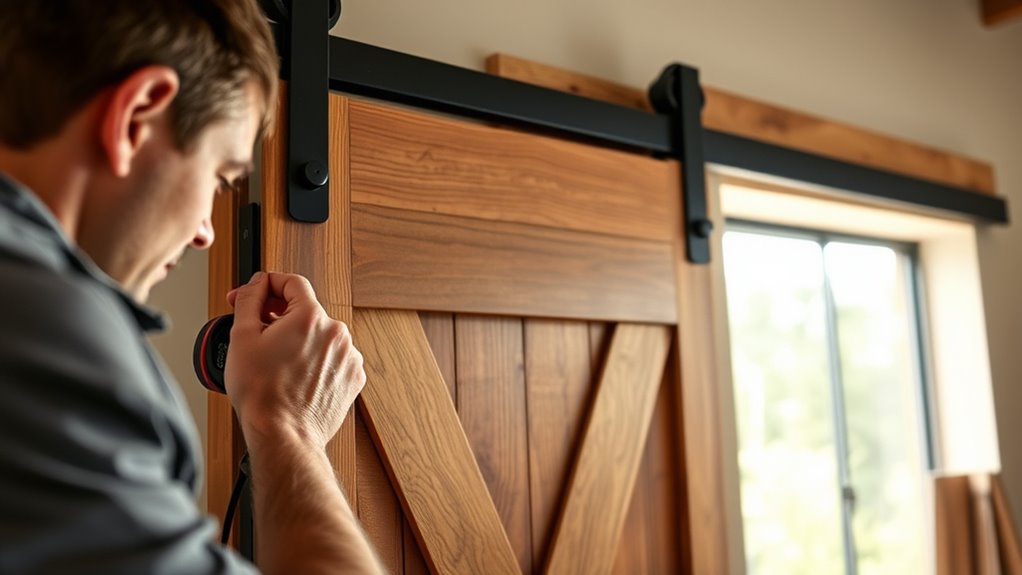To install a sliding barn door, start by selecting the right hardware that matches your door size and style, whether wall-mounted or ceiling mounted. Make certain you mount it securely, using studs or appropriate anchors to support the door’s weight. Consider your space and décor to choose a hardware finish that complements your room. Proper installation ensures smooth, quiet operation. Keep exploring for detailed tips that will help you achieve a professional look and function.
Key Takeaways
- Select the appropriate hardware system (wall-mounted or ceiling-mounted) based on your space and door weight.
- Measure the doorway accurately to determine the correct track length and door dimensions.
- Install the track securely into wall studs or ceiling joists to support the door’s weight properly.
- Hang the door on rollers, ensuring smooth movement and proper clearance from the floor and wall.
- Fine-tune the hardware adjustments for smooth operation and secure the door in the desired open or closed position.

Installing a sliding barn door can transform your space by adding rustic charm and saving room. It’s a stylish alternative to traditional doors, especially in areas where space is limited or where you want to introduce a unique design element. When you’re ready to install, one of the first things to consider is the hardware options. The hardware is the backbone of your barn door, determining how smoothly it slides and how well it fits your aesthetic. You’ll find a range of options, from classic black iron to sleek brushed nickel, each offering different looks and durability levels. Heavy-duty steel tracks are perfect if you want something sturdy that can support larger doors, while lighter aluminum options work well for smaller, more delicate doors. It’s essential to choose hardware that matches your door’s weight and size to guarantee smooth operation and longevity. Don’t forget to check the mounting system—most hardware kits include ceiling mounts or wall mounts, so think about which suits your space best. Wall-mounted hardware can offer a more minimalist look, while ceiling mounts might be better for rooms with limited wall space.
As you plan, pay close attention to aesthetic considerations. Your barn door isn’t just functional; it’s a design feature that can elevate the entire room. Think about the style you want to achieve—rustic, modern, industrial, or farmhouse—and select a door and hardware that complement that look. For example, if you’re going for a rustic vibe, distressed wood with black iron hardware can create a cohesive, warm feel. For a more modern look, sleek, smooth finishes with minimal hardware details work well. The color and material of your door also matter. You might opt for reclaimed wood for authenticity, or go for painted MDF if you prefer a more uniform appearance. The hardware’s finish should match or complement other fixtures in the room, such as light fixtures or cabinet handles, to create a harmonious design.
In addition to style, consider the hardware’s practicality. Look for options that include soft-close features or rollers that reduce noise and prevent the door from slamming. Proper installation is vital to guarantee your barn door operates smoothly and stays securely in place. Additionally, selecting hardware with adjustable settings can help fine-tune the operation for optimal performance. With the right hardware options and careful aesthetic planning, installing a sliding barn door becomes a straightforward project that adds both function and personality to your space. Take your time choosing each element, and you’ll enjoy a beautiful, space-saving feature that enhances your home’s overall design.
Frequently Asked Questions
Can I Install a Sliding Barn Door on Uneven Surfaces?
You can install a sliding barn door on uneven surfaces, but you’ll need to reinforce the wall and add ceiling support. Use shims or a leveler to create a stable track, ensuring smooth sliding. Reinforcing the wall with additional framing or brackets helps support the door’s weight, especially on uneven surfaces. Ceiling support can also prevent sagging and provide extra stability, making sure your barn door functions properly and looks great.
What Tools Are Essential for Installing a Sliding Barn Door?
You’ll need essential tools like a drill, level, measuring tape, and a stud finder. Use these to guarantee precise wall mounting techniques for secure installation. Don’t forget decorative hardware, which adds style and function. A saw might be necessary for trimming the door or rails. With these tools, you can confidently hang your sliding barn door, ensuring it operates smoothly and looks great.
How Do I Prevent the Door From Derailing?
You might think derailment’s inevitable, but with door derail prevention, it’s avoidable. First, guarantee perfect track alignment by double-checking the level and straightness. Use track alignment tips like securing the track firmly and checking for obstructions regularly. Avoid cheap hardware, and don’t forget to install proper rollers. These simple steps keep your door gliding smoothly, proving that derailment isn’t just a myth — it’s preventable with the right care.
Is It Possible to Install a Sliding Barn Door Without a Track?
Yes, you can install a sliding barn door without a traditional track by exploring alternative mounting methods. You might consider custom track options or wall-mounted hardware that secure the door directly to the wall, providing a sleek look without a rail on the ceiling. These alternatives allow for creative design, but guarantee your chosen method supports the door’s weight and movement smoothly. Proper installation is key for safety and functionality.
How Do I Choose the Right Weight Capacity for My Door?
You should choose a door with a weight that matches or is slightly below your track capacity. To do this, measure the door’s weight accurately and compare it to the track’s maximum weight rating. If your door is heavy, opt for a sturdy track designed to support higher weight capacities. Ensuring compatibility prevents track failure and guarantees smooth operation, so always prioritize matching door weight with your track capacity.
Conclusion
Now that you’ve installed your sliding barn door, you can visualize it as a gateway that seamlessly combines functionality with style. Think of it like a well-placed puzzle piece—when perfectly aligned, it completes the space and adds character. Just as a scientist tests a theory to see if it holds true, your installation proves that with the right steps, transforming your space is achievable. Enjoy your new door, and let it inspire confidence in your DIY skills!









